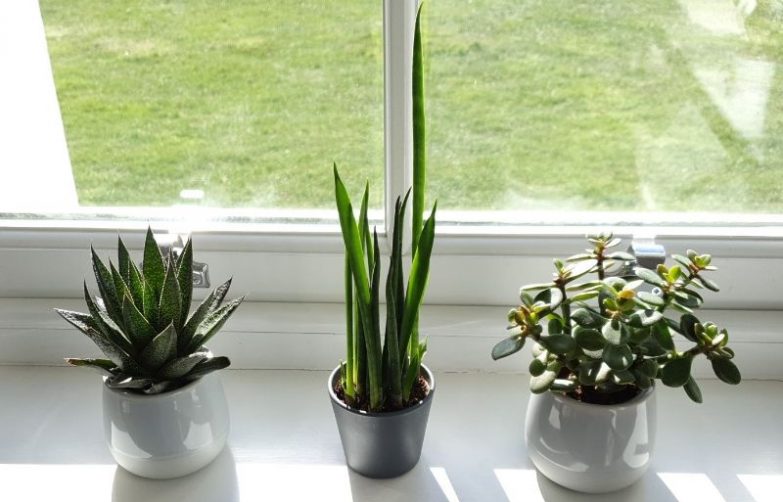Lighting conditions in your home will have a direct effect on the growth and health of your houseplants. Too little or too much light can cause your plants to look sickly, fail to grow and bloom, drop leaves or die altogether. In this guide, we discuss light requirements for indoor plants, how to provide the perfect amount of light, and how to solve lighting problems in houseplants.
Light Requirements for Indoor Plants
Indoor lighting for houseplants involves:
- Understanding how light affects plants
- Discovering the different types of light exposure
- The position or location of your lighting and plants
- When and how to use artificial lighting
- Diagnosing problems in struggling plants
- Choosing the right plants for the type of lighting in your home
Keep reading to understand how plants use light, how to understand the lighting in your home, and how you can use it to help your plants grow best. After reading this, you’ll be able to move your plants around your home to meet their light requirements as well as choose the best plants for the lighting you already have in your home. You’ll also be able to identify and respond to lighting problems early, to keep your plants in great condition.
Understanding How Light Affects Plants
Plants absorb sunlight and turn it into energy through a process called photosynthesis. Chloroplasts are organelles within plant cells that are responsible for photosynthesis. They use sunlight, combined with water and carbon dioxide, to make food for the plant.
Plants are able to respond to changing lighting levels by adjusting the number and distribution of these chloroplasts. In lower light, the plant needs to capture more of the light, and so the number of chloroplasts will generally increase. This often causes plant leaves to become darker green as an initial response to lower light conditions.
In higher light, the number of chloroplasts can be reduced, and they change their distribution within the leaves to absorb less light, often resulting in paler green-colored leaves when lighting levels are higher than ideal.
The ability of plants to adjust to changes in light is limited, and each plant species will have a maximum and minimum tolerable lighting level. In addition, adaptation takes time, so sudden changes in lighting are often the most detrimental to the health of your plants.
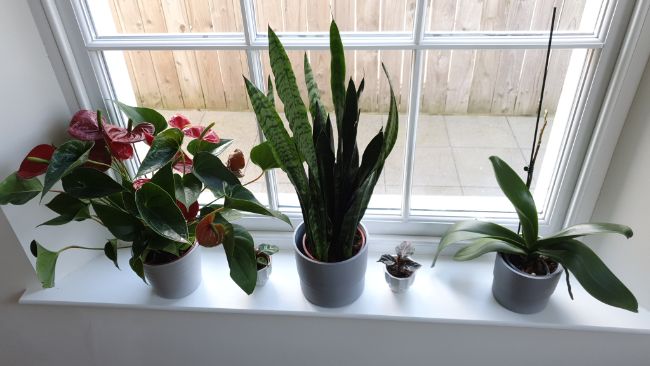
Factors Involved In Lighting
There are many factors involved in lighting for your houseplants. These include the direction of the windows, the intensity of the sunlight that comes through your windows, how the light changes throughout the day, how the light changes based on the season, and how weather affects the lighting, as well.
Location
The location of your plants in your home will have an effect on the amount of lighting they receive. You’ll need to know which direction the windows in your home face to help you understand the amount of light your plants will receive.
However, you may need to make adjustments depending on your latitude. Because the amount and timing of natural sunlight depend on the track of the sun, higher and lower latitudes will need to make adjustments for this. Also, mountains, hills, valleys, woods, and building structures may also change the way the sun hits your windows.
The Direction Of The Windows
As the sun rises in the east and sets in the west, you can expect lighting to be best in east-facing windows in the morning and west-facing windows in the late afternoon and evening.
In the northern hemisphere, south-facing windows will provide the greatest amount of direct sunlight, where north-facing windows will provide minimal direct sunlight. This, of course, differs in the southern hemisphere, where north-facing windows will provide the most direct sunlight and south-facing windows will provide the least.
The rest of this section assumes you live in the northern hemisphere.
South-Facing Windows
South-facing windows generally receive the most direct sunlight as long as the windows are not shaded out by a tree, canopy, or other structure. This is usually the strongest and brightest light that you can receive inside of your home. This is the best spot for those plants that need ‘direct’ sun indoors.
West-Facing Windows
While west-facing windows receive less intense sunlight than south-facing windows, they still receive direct sunlight for a portion of the day, in the afternoon and early evening.
Western windows will receive more indirect light in the early morning and early afternoon. The afternoon sun is intense and can increase the temperature near the window, so be careful with plants that could scorch easily and move them a few feet away from the window.
East-Facing Windows.
East facing windows receive direct sun in the early morning when the rays are not as hot. Later, the same windows will receive indirect light, avoiding the scorching heat. Plants that need bright indirect light do well in east-facing windows. Here are some of my favorite houseplants that are perfect for east-facing windows.
North-Facing Windows
North facing windows receive the least amount of light. These windows do not receive any direct sunlight and work well for plants such as ferns that have low light requirements. During the summer, the amount of light close to a north-facing window is generally sufficient for most plants requiring bright, indirect light. As lighting decreases rapidly as you move from a window, locations more than a few feet away from the window are best for low light plants.
In winter, a north-facing windowsill is usually sufficient to meet the light requirements for indoor plants requiring low-light, but other plants are best moved to a higher light location, or you could use a supplemental grow light. Here are some great houseplants for norther-facing windows.
How To Make Light Less Intense
If you only have a south-facing window but need a lower intensity of light for your houseplants, you can filter the light to tone it down.
- Window Sheers. Window sheers are lightweight, sheer curtains that will cut down on the light intensity that comes through the window.
- Window Films. Window films are available that block out varying levels of UV rays. This is especially helpful to protect more sensitive plants from the harsh rays of the summer sun in south-facing windows.
- Placement. You may need to move your plants a few feet back from the window to avoid the direct rays, but in a spot in the room that still receives bright indirect light.
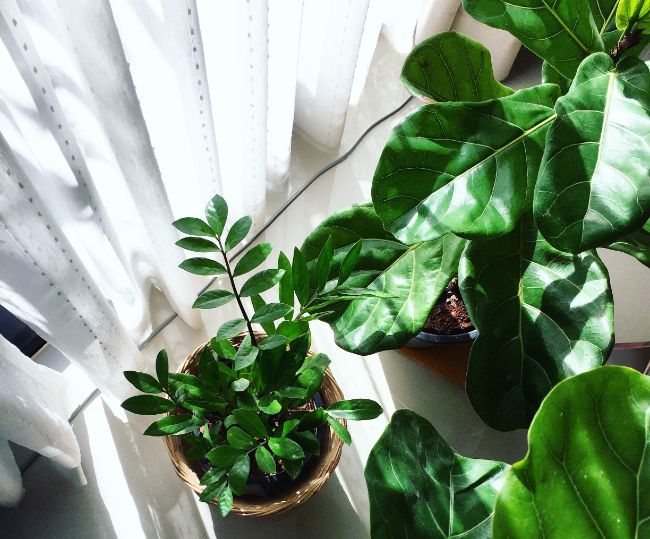
Lighting Factors
Lighting for your plants can also be evaluated by considering the following three factors:
Intensity
Intensity is the brightness of the light, which is a critical factor for houseplants. Light brightness falling on a surface is often measured in foot candles. A foot-candle is defined as the amount of light that falls on a surface that is one foot away from a single candle. Light intensity can also be measured in Lux (1 foot-candle = 10.764 lux).
- Full Sun – (40,000–130,000 lux; 5000 foot candles+). All else being equal, direct light outside has about twice the intensity of direct light indoors. It is not possible to achieve this level of lighting indoors because glass windows filter the light, reducing its intensity.
- Direct Light Indoors – (20,000–50,000 lux; 2,000–5,000 foot-candles). Direct light indoors is considered to be light falling directly on an indoor surface that has passed through a window. It will feel warm on your skin and will produce distinct shadows. Direct light indoors is considerably weaker than direct sunlight outdoors, at about 2000 to 5000 foot-candles. Despite being filtered by glass, direct light indoors can cause sun damage to many indoor plants, unless they are specifically suited to direct sunlight. Many succulents, cacti, and flowering indoor plants thrive in direct indoor light.
- Bright Indirect light – (10,000–20,000 lux; 1,000–2,000 foot-candles). Bright indirect light is a bright location with no direct rays from the sun. This equates to about 1000 to 2000 foot-candles. Bright indirect light will still cast a shadow if you block it, but the edges of the shadow will be fainter and less well defined. You can achieve bright, indirect light in most east, west and south-facing rooms by adjusting distance and positioning of your plants within the room.
- Medium Light – (2,500–10,000 lux; 250–1,000 foot-candles). This is similar to the light in an east-facing room when standing a few feet from the window on a bright day. Many foliage houseplants such as Calatheas, Philodendrons, Alocasias, Dracaenas will grow and do well in medium lighting.
- Low Light – (500–2,500 lux, 50–250 foot-candles). Away from the window of an east- or west-facing room, or within a few feet of a north-facing window: Bear in mind that most people can read comfortably in a location providing only 25 foot-candles of light, so what is considered “low light” may be brighter than you think.
- Very Low Lighting – (<500 lux, <50 foot-candles). The lighting will seem dull. In winter, lighting just a few feet from a window can fall into the very low light range. Plants such as Snake plants, Cast-Iron plants, Chinese Evergreens, etc will survive, but maybe not thrive in very low lighting.
There are a number of free and premium light meter apps available for iPhone and Android which will give you a reading of the available light in your home. “Luminous Meter” and “Lux Light Meter are two good free options. These apps can help you to meet the light requirements of your plants by objectively measuring lighting and moving your plants as needed.
Duration
The number of hours of light per day will change depending on the season, but also depending on a range of other factors. Due to the size of the window or external obstructions, your room may only get a limited duration of quality light per day.
Be sure to assess a room at different times of the day to ensure that it receives an appropriate duration of light for the plant you plan to position there.
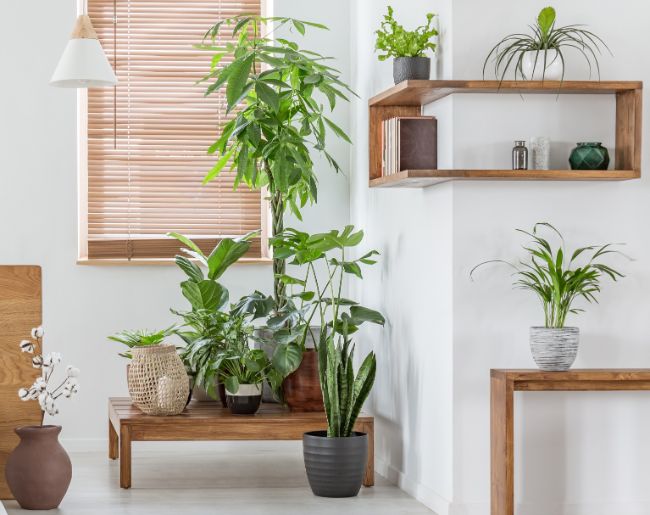
How Lighting Changes Throughout the Day
As the sun moves across the sky, the lighting that comes in through the windows will change. In a south-facing window, the sun will hit the window for the entire day. In a West facing window, the sun will hit the window directly in the afternoon, but indirectly in the morning and early afternoon.
In an east-facing window, the sun will shine directly on it in the morning, when the rays aren’t quite as intense. In the afternoon, an east-facing window will receive indirect light. A north-facing window does not receive any direct light.
Seasonal Lighting Changes
The changing of the seasons will also change the amount of light coming in through your windows. In the summer, due to the position of the earth in relation to the sun, the sun’s rays are more intense and longer in duration each day.
This means the light coming in through your windows will be brighter and more intense for a longer period of time. On the other hand, in the winter, the days are shorter with fewer hours of daylight and less intense light.
You may need to adjust the location of your plants due to the season. For example, a plant that thrives in a western facing window in the summer might need to be moved to a southern facing window in the winter to receive more daylight.
Conversely, a plant that does well in the winter in a south-facing window might be scorched by the intensity of the sun in the summer. If this happens, the plant would do better by being moved a few feet away from the window or moved to a western or eastern facing window where it will receive less intense light during the summer.
Plants rarely grow well in a north-facing window in the wintertime, but shade-loving plants may do well in those windows in the summer when the light is brighter for a longer period of time.
Lighting Changes Due To Weather
When the weather is bad, lighting from the sun will change. Overcast, cloudy, or rainy weather will prevent the sun’s rays from shining into your home. But it will take at least a week or two of poor weather to have a negative effect on your houseplants, so even houseplants that need direct light indoors should be ok for several weeks.
For long, harsh winters, you may want to consider adding supplemental lighting or moving your plants to different windows to meet the light requirements for indoor plants in your home. Many houseplants will go dormant over the winter due to a decrease in sunlight hours.
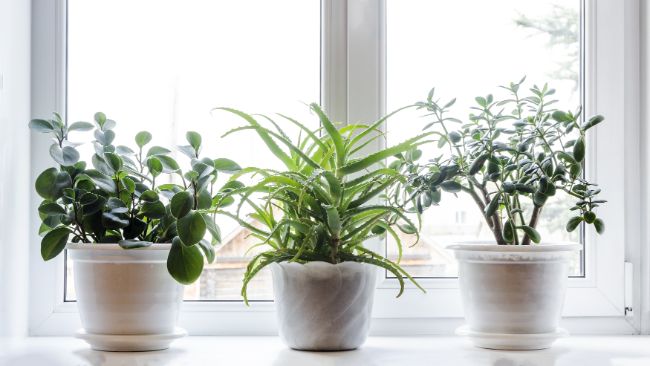
Will A Plant That Is Meant To Have Bright Indirect Light Tolerate a Few Hours Of Direct Sunlight?
Plants that are meant to have bright indirect light are usually ok with 1-2 hours of direct sunlight per day, but it completely depends on the plant. Some delicate houseplants such as calatheas can scorch easily even with a few hours of direct sunlight.
Plants placed in excessively bright conditions may become pale before they begin to scorch, so you may have time to save the plant before the damage is severe. Look for leaf yellowing affecting sun-exposed and newer leaves first. If you notice evidence of excessive lighting, move your plant to a less bright location or take steps to shield the plant from intense light.
The closer to the window, the more intense the sun’s rays will be. As you move the plant further away from the window, the light rays are scattered throughout the room.
The lower the light requirements for indoor plants, the further you can move them from a window. Taking measurements with a light meter throughout your room will help you know where in the room to place your plant according to the number of foot-candles each spot receives.
Plant Location Ideas
If your plants need bright indirect light, east or west-facing windows are a good choice. South-facing rooms can also work well, but you will need to position your plant away from the window or shield it from direct sunlight. These types of plants should also do well in a room where the sun shines for several hours each day.
Plants with low light requirements will usually do best in bright, indirect light, but will also tolerate levels well away from an east-facing window or at the window of a north-facing room.
Every home, room, day and season provides different light conditions. The best thing you can do is to observe the lighting in your room for a while, either manually or using a light meter. Choose a plant for the location only once you have a good idea of the amount of light available. This will lead to a happier plant and will make looking after it a much easier task.
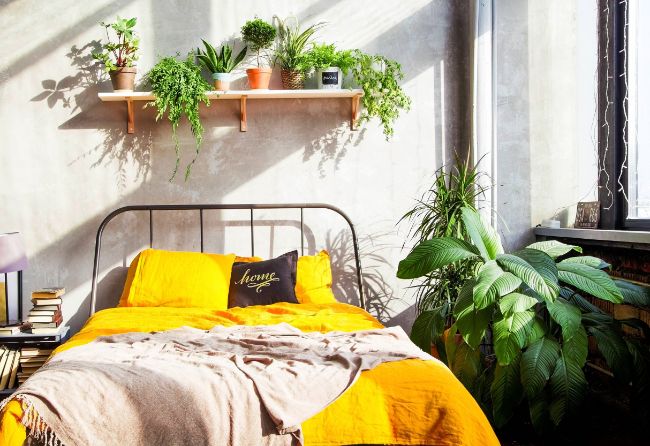
Artificial Lighting
If you simply cannot meet your plant’s light requirements with natural light, you can provide artificial light for your plants. There are many options to choose from, including LED or fluorescent grow lights, which come in a wide variety of sizes, form factors, and power outputs.
I usually prefer to use LED spotlights to provide supplemental lighting for some of my houseplants in the winter, but generally try to move my houseplants around my home where possible to provide natural light at other times.
A combination of the light’s level of output and the plant’s light needs will determine how close or far you need to put the light from the plant. Even a few hours of artificial lighting per day can make a big difference to the health of a light-deprived houseplant.
Diagnosing Lighting Problems In Indoor Plants
Watch your plant closely over time, as it will show signs that it is receiving too much or too little light before any permanent damage is done. The more quickly you can correct any problems, the better your plant will respond and the more likely it is to survive and thrive.
Low Light
Many plants can tolerate the wrong lighting conditions for a short period of time, so it may take a while for symptoms or problems to be obvious. Also, you will need to make sure there isn’t some other problem, such as watering difficulties, pests, or diseases that may mimic the symptoms a plant experiences when the lighting is too strong or too weak.
Plants that do not receive enough light will begin to look tall and spindly, in a process called etiolation. This is sometimes called legginess. You might see long spaces between the leaves as the plant stretches out to try to find more sunlight.
Sometimes, the leaves of some plants exposed to insufficient light can become darker green. It is easy to mistakenly think this is a sign of good health, but it will soon be followed by yellowing and leaf drop, or other signs of poor health.
The lower leaves of the plant may start to turn yellow and fall off as the plant tries to conserve its energy. The growth of the plant may be slow, stunted, or it may stop growing completely. Any new leaves that form might be smaller than the existing leaves.
A flowering plant may fail to bloom or the blooms may be weak or few in number. Plants that are normally variegated may lose their stripes and turn a solid green color, or leaves may become pale due to too little photosynthesis to produce the green coloring in the plant.
If you think your plant is not receiving enough light, move it to a brighter location. Avoid moving a plant from low light to direct sunlight, as the plant is unlikely to tolerate this. Just like humans, they need to acclimatize to new conditions. Although most plants will tolerate considerable change, moving more sensitive houseplants to increasingly brighter conditions over a few days is a good option.
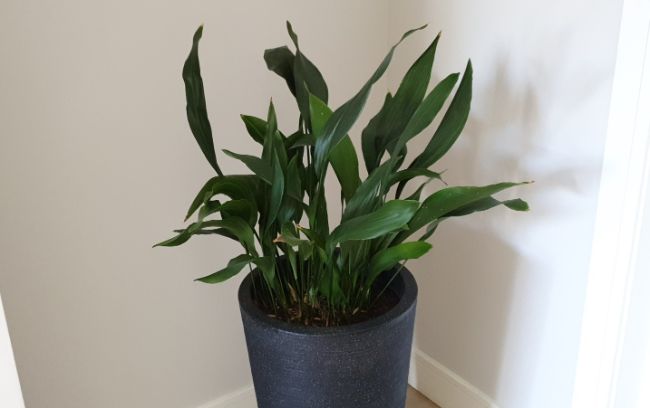
Excessive Light
If your plants are receiving too much light, they will also show you symptoms. Look for patches on the leaves that are brown or scorched looking, indicating that your plant has been burned because the light is too strong for it. Leaves may look faded, washed out, or pale. The plant may get too hot or dry and wilt in the bright sun.
You may find that the soil dries out much too quickly, as well. Eventually, the leaves will dry out and fall off. When they fall, they may have more of a crunchy, crispy feel to them, rather than the yellow, soft feeling of a leaf that has fallen due to lack of sunlight.
If you feel like your plant is receiving too much light, you can move it to a window that receives less light. You can also move it out of the direct sunlight. You might try moving it further away from the window to a corner of the room, or at least move it off to the side of the window where it will still receive bright but less direct light.
Light Requirements For Indoors Plants – Choosing Plants
To get the best results, you should choose plants for the lighting you have in your home. When you go to purchase your next plant, think about where you are planning to put it. Is it in a bedroom that receives very little light? Then you’ll want to choose a low light plant. Or maybe it is in a bright, sunny kitchen window that faces south. You’ll want to choose a plant that loves the sun.
Use the following lists of plants and their lighting needs to help you choose the best plant for your home. Generally, the plant tag that comes with your new plant will tell you how to care for your plant, including what type of lighting conditions your new plant will need to thrive.
Low Light Plants
Plants with low light requirements are typically shade-loving plants that will do well in 500-1000 foot candles of light or in a north-facing window during spring, summer, and fall. They will also do well in the same room as a south-facing window as long as they are away from the direct light. These plants include:
- Arrowhead Vine
- Cast Iron Plant
- Chinese evergreen
- Dumb Cane
- Dracaena
- English Ivy
- Parlor Palm
- Peace Lily
- Philodendron
- Ponytail palm
- Pothos
- Snake plant or Mother-in-law’s tongue
- ZZ plant
Medium Light Plants
Plants that have medium light requirements are the easiest to position in your home and are generally fairly adaptable. They will do well in east- or west-facing windows, or away from the window in a south-facing room. They may not grow or bloom if they have too little or too much light. Approximately 1000 foot candles will help these plants grow at their best.
- African Violet
- Anthurium
- Asparagus Fern
- Begonias
- Calatheas
- Christmas Cactus
- Croton
- Cyclamen
- Fiddleleaf Fig
- Grape Ivy
- Hoya
- Jade Plant
- Norfolk Island pine
- Peperomia
- Rubber plant
- Spider plant
High Light Plants
Plants that have high light requirements will enjoy the direct sun of a south-facing window. Some are best moved from intense rays in summer and some may need a little supplemental light in the winter.
- Cacti and many succulents
- Citrus Trees
- Desert Rose
- Euphorbia
- Gardenia
- Herbs
- Hibiscus
- Jasmine
- Kalanchoe
- Oxalis Triangularis
- String of Pearls
- Sweet Potato Vines
With a little practice, you’ll be able to determine the best places in your home to grow your favorite house plants. Keeping a close watch on your plants will help you spot problems early so that you can adjust the lighting or location for your plant. Knowing the lighting resources that you have in your home will help you choose the best plants to enjoy in your home.

